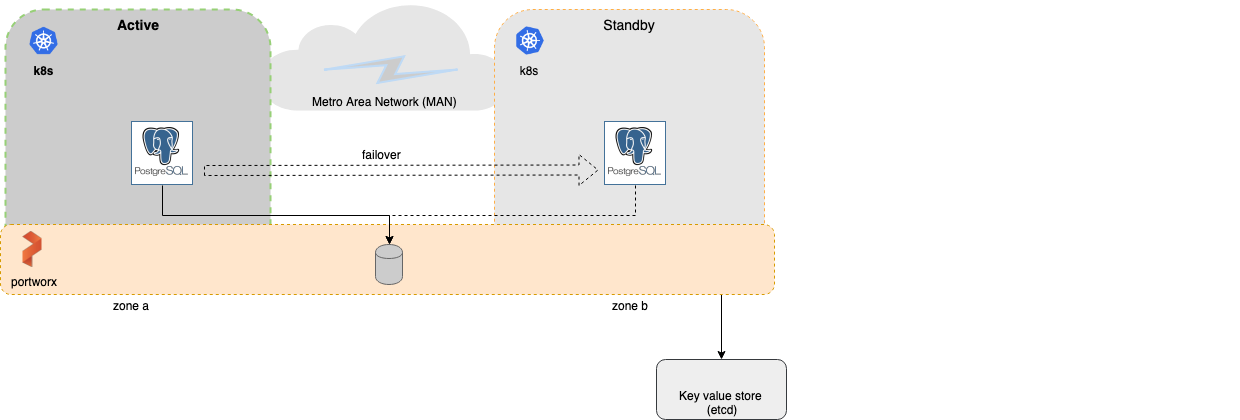Disaster Recovery (DR) for Kubernetes
This section describes the different methods for achieving Disaster Recovery (DR) between multiple Kubernetes clusters when using Portworx.
There are 2 primary options for this:
- Synchronous DR: Nodes are in the same Metro Area Network (MAN)
- Asynchronous DR: Nodes are across different regions/datacenters
storkctl.
Choosing between these options depends on how your cluster nodes are laid out. Below section helps you make that choice.
1. Synchronous DR: Nodes are in the Metro Area Network (MAN)

When
You should use this option when:
- Nodes in all your Kubernetes clusters are in the same Metro Area Network (MAN). These could be nodes that are in
- The same cloud region. They can be in different zones.
- The same datacenter or datacenters that are just 50 miles apart.
- The network latency between the nodes is lower than ~10ms.
What
The option has the following characteristics:
- A single Portworx cluster that stretches across multiple Kubernetes clusters.
- Portworx installation on all clusters use a common external key-value store (e.g etcd).
- Volumes are automatically replicated across the Kubernetes clusters as they share the same Portworx storage fabric.
- This option will have zero RPO and RTO less than 60 seconds.
Portworx quorum overview
In a Portworx cluster, a quorum is the minimum number of online storage nodes required for the cluster to be up and running. If any additional nodes go offline beyond this threshold, then the cluster loses quorum causing all operations to stop and Portworx does not process any IOs.
In a Synchronous DR setup, one Portworx cluster stretches across two data centers in a Metro Area Network. The same quorum rules apply in such a deployment. All the storage nodes across these two data centers contribute to quorum.
When you deploy Portworx clusters in the Synchronous DR method, Portworx quorum can be lost in the event of a data center failure or network partition.
Using a witness node
To solve the quorum issue, you can deploy a witness site that is used as the quorum tie-breaker when there is a network partition or when a data center goes offline. The witness node is a single virtual machine and a special Portworx storage-less node that participates in quorum, but does not store any data. A witness node is usually in another third data center.
Using external etcd
Portworx does not support internal kvdb with Synchronous DR. You need to set up a separate, three node etcd cluster for Portworx. One etcd node needs to be running in each data center and one node should be running on the witness node.
How
Click on the section below for instructions on how to setup this option.
2. Asynchronous DR:Nodes are across different regions/datacenters

When
You should use this option when:
- Nodes in all your Kubernetes clusters are in the different regions or datacenter.
- The network latency between the nodes is high.
What
The option has the following characteristics:
- A separate Portworx cluster installation for each Kubernetes clusters.
- Portworx installations on each cluster can use their own key-value store (e.g etcd).
- Users create scheduled migrations of application and volumes between 2 clusters that are paired.
- This option will have an RPO of 15 minutes and RTO less than 60 seconds.
How
Click on the section below to instructions on how to setup this option.
Licensing
Please note that the Disaster Recovery (PX-DR) license is not included with the Portworx Enterprise Trial license. If you are interested in testing or purchasing this functionality, please reach out to us at support@portworx.com.
